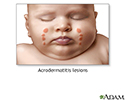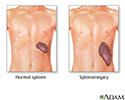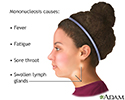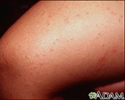Mononucleosis
Mono; Kissing disease; Glandular fever
Mononucleosis, or mono, is a viral infection that causes fever, sore throat, and swollen lymph glands, most often in the neck.
Causes
Mono is often spread by saliva and close contact. It is known as "the kissing disease." Mono occurs most often in people ages 15 to 17, but the infection may develop at any age.
Mono is usually linked to the Epstein-Barr virus (EBV). Rarely, it is caused by other viruses, such as cytomegalovirus (CMV).
Symptoms
Mono may begin slowly with fatigue, a general ill feeling, headache, and sore throat. The sore throat slowly gets worse. Your tonsils become swollen and develop a whitish-yellow covering. Often, the lymph nodes in the neck are swollen and painful.
A pink, measles-like rash can occur, and is more likely if you take the medicine ampicillin or amoxicillin for a throat infection. (Antibiotics should NOT be given without a test that shows you have a strep infection.)
Common symptoms of mono include:
-
Drowsiness
Drowsiness
Drowsiness refers to feeling abnormally sleepy during the day. People who are drowsy may fall asleep in inappropriate situations or at inappropriate...
Read Article Now Book Mark Article -
Fever
Fever
Fever is the temporary increase in the body's temperature in response to a disease or illness. A child has a fever when the temperature is at or abov...
 ImageRead Article Now Book Mark Article
ImageRead Article Now Book Mark Article - General discomfort, uneasiness, or ill feeling
-
Loss of appetite
Loss of appetite
A decreased appetite is when your desire to eat is reduced. The medical term for a loss of appetite is anorexia.
Read Article Now Book Mark Article -
Muscle aches
or stiffness
Muscle aches
Muscle aches and pains are common and can involve more than 1 muscle. Muscle pain also can involve ligaments, tendons, and fascia. Fascia are the s...
 ImageRead Article Now Book Mark Article
ImageRead Article Now Book Mark Article -
Rash
Rash
Rashes involve changes in the color, feeling or texture of your skin.
 ImageRead Article Now Book Mark Article
ImageRead Article Now Book Mark Article - Sore throat
-
Swollen lymph nodes
, most often in the neck and armpit
Swollen lymph nodes
Lymph nodes are present throughout your body. They are an important part of your immune system. Lymph nodes help your body recognize and fight germ...
 ImageRead Article Now Book Mark Article
ImageRead Article Now Book Mark Article
Less common symptoms are:
-
Chest pain
Chest pain
Chest pain is discomfort or pain that you feel anywhere along the front of your body between your neck and upper abdomen.
 ImageRead Article Now Book Mark Article
ImageRead Article Now Book Mark Article -
Cough
Cough
Coughing is an important way to keep your throat and airways clear. But too much coughing may mean you have a disease or disorder. Some coughs are d...
 ImageRead Article Now Book Mark Article
ImageRead Article Now Book Mark Article -
Fatigue
Fatigue
Fatigue is a feeling of weariness, tiredness, or lack of energy.
Read Article Now Book Mark Article -
Headache
Headache
A headache is pain or discomfort in the head, scalp, or neck. Serious causes of headaches are rare. Most people with headaches can feel much better...
 ImageRead Article Now Book Mark Article
ImageRead Article Now Book Mark Article -
Hives
Hives
Hives are raised, often itchy, red bumps (welts) on the surface of the skin. They are usually an allergic reaction to food or medicine. They can al...
 ImageRead Article Now Book Mark Article
ImageRead Article Now Book Mark Article - Jaundice (yellow color to the skin and whites of the eyes)
- Neck stiffness
-
Nosebleed
Nosebleed
A nosebleed is loss of blood from the tissue lining the nose. Bleeding most often occurs in 1 nostril only.
 ImageRead Article Now Book Mark Article
ImageRead Article Now Book Mark Article -
Rapid heart rate
Rapid heart rate
A bounding pulse is a strong throbbing felt over one of the arteries in the body. It is due to a forceful heartbeat.
 ImageRead Article Now Book Mark Article
ImageRead Article Now Book Mark Article -
Sensitivity to light
Sensitivity to light
Photophobia is eye discomfort in bright light.
 ImageRead Article Now Book Mark Article
ImageRead Article Now Book Mark Article -
Shortness of breath
Shortness of breath
Breathing difficulty may involve:Difficult breathingUncomfortable breathingFeeling like you are not getting enough air
 ImageRead Article Now Book Mark Article
ImageRead Article Now Book Mark Article
Exams and Tests
Your health care provider will examine you. They may find:
- Swollen lymph nodes in the front and back of your neck
- Swollen tonsils with a whitish-yellow covering
- Swollen liver or spleen
- Skin rash
Blood tests will be done, including:
- White blood cell (WBC) count: will be higher than normal if you have mono
-
Monospot test
: will be positive for infectious mononucleosis
Monospot test
The mononucleosis spot test looks for 2 antibodies in the blood. These antibodies appear during or after an infection with the virus that causes mon...
 ImageRead Article Now Book Mark Article
ImageRead Article Now Book Mark Article -
Antibody titer
: tells the difference between a current and past infection
Antibody titer
Antibody titer is a laboratory test that measures the level of antibodies in a blood sample.
 ImageRead Article Now Book Mark Article
ImageRead Article Now Book Mark Article
Treatment
The goal of treatment is to relieve symptoms. Steroid medicine (prednisone) may be given if your symptoms are severe.
Antiviral drugs, such as acyclovir, have little or no benefit.
To relieve typical symptoms:
- Drink plenty of fluids.
- Gargle with warm salt water to ease a sore throat.
- Get plenty of rest.
- Take acetaminophen or ibuprofen for pain and fever.
Also avoid contact sports if your spleen is swollen (to prevent it from rupturing).
Outlook (Prognosis)
The fever usually drops in 10 days, and swollen lymph glands and spleen heal in 4 weeks. Tiredness usually goes away within a few weeks, but it may linger for 2 to 3 months.
Possible Complications
Complications of mononucleosis may include:
- Anemia, which occurs when red blood cells in the blood die sooner than normal
-
Hepatitis
with jaundice (more common in people older than 35)
Hepatitis
Hepatitis is swelling and inflammation of the liver.
 ImageRead Article Now Book Mark Article
ImageRead Article Now Book Mark Article - Swollen or inflamed testicles
-
Nervous system problems (rare), such as
Guillain-Barré syndrome
, meningitis,
seizures
, damage to the nerve that controls movement of the muscles in the face (
Bell's palsy
), and uncoordinated movements
Guillain-Barré syndrome
Guillain-Barré syndrome is a serious health problem that occurs when the body's defense (immune) system mistakenly attacks part of the nervous system...
 ImageRead Article Now Book Mark Article
ImageRead Article Now Book Mark ArticleSeizures
A seizure is the physical findings or changes in behavior that occur after an episode of abnormal electrical activity in the brain. The term "seizure...
 ImageRead Article Now Book Mark Article
ImageRead Article Now Book Mark ArticleBell's palsy
Bell palsy is a disorder of the nerve that controls movement of the muscles in the face. This nerve is called the facial or seventh cranial nerve. D...
 ImageRead Article Now Book Mark Article
ImageRead Article Now Book Mark Article - Spleen rupture (rare, avoid pressure on the spleen)
-
Skin rash
(uncommon)
Skin rash
Acrodermatitis is a childhood skin condition that may be accompanied by mild symptoms of fever and malaise. It may also be associated with hepatitis...
 ImageRead Article Now Book Mark Article
ImageRead Article Now Book Mark Article
Death is possible in people who have a weakened immune system.
When to Contact a Medical Professional
The early symptoms of mono feel very much like any other illness caused by a virus. You do not need to contact a provider unless your symptoms last longer than 10 days or you develop:
- Abdominal pain
- Breathing difficulty
- Persistent high fevers (more than 101.5°F or 38.6°C)
- Severe headache
- Severe sore throat or swollen tonsils
- Weakness in your arms or legs
- Yellow color in your eyes or skin
Call 911 or go to an emergency room if you develop:
- Sharp, sudden, severe abdominal pain
- Stiff neck or severe weakness
- Trouble swallowing or breathing
Prevention
People with mono may be contagious while they have symptoms and for up to a few months afterwards. How long someone with the disease is contagious varies. The virus can live for several hours outside the body. Avoid kissing or sharing utensils if you or someone close to you has mono.
References
Bope ET, Kellerman RD. Symptomatic care pending diagnosis. In: Bope ET, Kellerman RD, eds. Conn's Current Therapy 2016 . Philadelphia, PA: Elsevier; 2016:chap 1.
Jenson HB. Epstein-Barr virus. In: Kliegman RM, Stanton BF, St Geme JW, Schor NF, eds. Nelson Textbook of Pediatrics . 20th ed. Philadelphia, PA: Elsevier; 2015:chap 254.
Johannsen EC, Kaye KM. Epstein-Barr virus (infectious mononucleosis, Epstein-Barr virus-associated malignant diseases, and other diseases). In: Mandell GL, Bennett JE, Dolin R, eds. Mandell, Douglas, and Bennett's Principles and Practice of Infectious Diseases . 8th ed. Philadelphia, PA: Elsevier Saunders; 2014:chap 141.
Schooley RT. Epstein-Barr virus infection. In: Goldman L, Schafer AI, eds. Goldman's Cecil Medicine . 25th ed. Philadelphia, PA: Elsevier Saunders; 2016:chap 377.
-
Mononucleosis, photomicrograph of cells - illustration
This so-called "Downy cell" is typical of lymphocytes infected by EBV (Epstein Barr Virus) or CMV (Cytomegalovirus) in infectious mononucleosis. Downy cells may be classified as types I, II, or III. This is a type II Downy cell.
Mononucleosis, photomicrograph of cells
illustration
-
Mononucleosis, photomicrograph of cells - illustration
This is a lymphocyte that has been infected by the Epstein-Barr Virus (EBV) or Cytomegalovirus (CMV) in infectious mononucleosis and is referred to as a "Downy cell". Downy cells may be classified as types I, II, or III; this is a type I Downy cell.
Mononucleosis, photomicrograph of cells
illustration
-
Infectious mononucleosis #3 - illustration
Infectious mononucleosis is caused by the Epstein-Barr virus. It is a viral infection causing high temperature, sore throat, and swollen lymph glands. Infectious mononucleosis can be contagious if the infected person comes in close or intimate contact with another person through saliva or sexual contact.
Infectious mononucleosis #3
illustration
-
Acrodermatitis - illustration
Acrodermatitis enteropathica is a skin condition peculiar to children that may be accompanied by mild symptoms of fever and malaise. It may also be associated with hepatitis B infection or other viral infections. The lesions appear as small coppery-red, flat-topped firm papules that appear in crops and sometime in long linear strings, often symmetric.
Acrodermatitis
illustration
-
Splenomegaly - illustration
Splenomegaly is an enlargement of the spleen.
Splenomegaly
illustration
-
Infectious mononucleosis - illustration
Swollen lymph nodes, sore throat, fatigue and headache are some of the symptoms of mononucleosis, which is caused by the Epstein-Barr virus. It is generally self-limiting and most patients can recover in 4 to 6 weeks without medications.
Infectious mononucleosis
illustration
-
Mononucleosis, photomicrograph of cell - illustration
This picture shows large, atypical lymphocytes (white blood cells). These cells are seen in viral infections, most commonly caused by the Epstein-Barr virus (infectious mononucleosis), cytomegalovirus diseases, and occasionally infectious hepatitis. This is an example of a type I Downy cell.
Mononucleosis, photomicrograph of cell
illustration
-
Gianotti-Crosti syndrome on the leg - illustration
Gianotti-Crosti disease is also called acrodermatitis of childhood. These red, elevated lesions do not contain pus and can occur on the limbs, buttocks, face, and neck.
Gianotti-Crosti syndrome on the leg
illustration
-
Mononucleosis - view of the throat - illustration
Infectious mononucleosis causes a sore throat, enlarged lymph nodes, and fatigue. The throat may appear red and the tonsils covered with a whitish material. Mononucleosis and severe streptococcal tonsillitis appear quite similar. Unless there are other findings to suggest mononucleosis, a throat culture and blood studies may be necessary to make an accurate diagnosis.
Mononucleosis - view of the throat
illustration
-
Mononucleosis - mouth - illustration
Infectious mononucleosis is caused by the Epstein-Barr virus. In teenagers and young adults, there is frequently a sore throat and red tonsils with whitish spots (exudate), as seen in this picture. Enlarged lymph nodes and fatigue are also common.
Mononucleosis - mouth
illustration
-
Antibodies - illustration
Antigens are large molecules (usually proteins) on the surface of cells, viruses, fungi, bacteria, and some non-living substances such as toxins, chemicals, drugs, and foreign particles. The immune system recognizes antigens and produces antibodies that destroy substances containing antigens.
Antibodies
illustration
-
Mononucleosis, photomicrograph of cells - illustration
This so-called "Downy cell" is typical of lymphocytes infected by EBV (Epstein Barr Virus) or CMV (Cytomegalovirus) in infectious mononucleosis. Downy cells may be classified as types I, II, or III. This is a type II Downy cell.
Mononucleosis, photomicrograph of cells
illustration
-
Mononucleosis, photomicrograph of cells - illustration
This is a lymphocyte that has been infected by the Epstein-Barr Virus (EBV) or Cytomegalovirus (CMV) in infectious mononucleosis and is referred to as a "Downy cell". Downy cells may be classified as types I, II, or III; this is a type I Downy cell.
Mononucleosis, photomicrograph of cells
illustration
-
Infectious mononucleosis #3 - illustration
Infectious mononucleosis is caused by the Epstein-Barr virus. It is a viral infection causing high temperature, sore throat, and swollen lymph glands. Infectious mononucleosis can be contagious if the infected person comes in close or intimate contact with another person through saliva or sexual contact.
Infectious mononucleosis #3
illustration
-
Acrodermatitis - illustration
Acrodermatitis enteropathica is a skin condition peculiar to children that may be accompanied by mild symptoms of fever and malaise. It may also be associated with hepatitis B infection or other viral infections. The lesions appear as small coppery-red, flat-topped firm papules that appear in crops and sometime in long linear strings, often symmetric.
Acrodermatitis
illustration
-
Splenomegaly - illustration
Splenomegaly is an enlargement of the spleen.
Splenomegaly
illustration
-
Infectious mononucleosis - illustration
Swollen lymph nodes, sore throat, fatigue and headache are some of the symptoms of mononucleosis, which is caused by the Epstein-Barr virus. It is generally self-limiting and most patients can recover in 4 to 6 weeks without medications.
Infectious mononucleosis
illustration
-
Mononucleosis, photomicrograph of cell - illustration
This picture shows large, atypical lymphocytes (white blood cells). These cells are seen in viral infections, most commonly caused by the Epstein-Barr virus (infectious mononucleosis), cytomegalovirus diseases, and occasionally infectious hepatitis. This is an example of a type I Downy cell.
Mononucleosis, photomicrograph of cell
illustration
-
Gianotti-Crosti syndrome on the leg - illustration
Gianotti-Crosti disease is also called acrodermatitis of childhood. These red, elevated lesions do not contain pus and can occur on the limbs, buttocks, face, and neck.
Gianotti-Crosti syndrome on the leg
illustration
-
Mononucleosis - view of the throat - illustration
Infectious mononucleosis causes a sore throat, enlarged lymph nodes, and fatigue. The throat may appear red and the tonsils covered with a whitish material. Mononucleosis and severe streptococcal tonsillitis appear quite similar. Unless there are other findings to suggest mononucleosis, a throat culture and blood studies may be necessary to make an accurate diagnosis.
Mononucleosis - view of the throat
illustration
-
Mononucleosis - mouth - illustration
Infectious mononucleosis is caused by the Epstein-Barr virus. In teenagers and young adults, there is frequently a sore throat and red tonsils with whitish spots (exudate), as seen in this picture. Enlarged lymph nodes and fatigue are also common.
Mononucleosis - mouth
illustration
-
Antibodies - illustration
Antigens are large molecules (usually proteins) on the surface of cells, viruses, fungi, bacteria, and some non-living substances such as toxins, chemicals, drugs, and foreign particles. The immune system recognizes antigens and produces antibodies that destroy substances containing antigens.
Antibodies
illustration
-
Mononucleosis
(Alt. Medicine)
Review Date: 2/15/2016
Reviewed By: Neil K. Kaneshiro, MD, MHA, Clinical Assistant Professor of Pediatrics, University of Washington School of Medicine, Seattle, WA. Also reviewed by David Zieve, MD, MHA, Isla Ogilvie, PhD, and the A.D.A.M. Editorial team.












